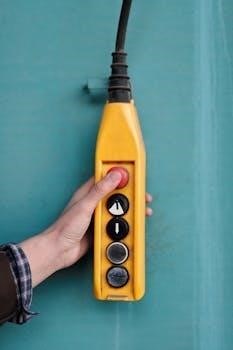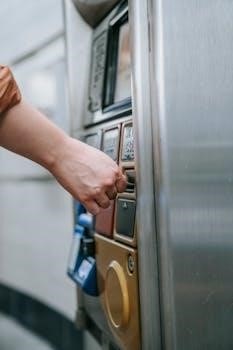Automated Logic Thermostat User Manual⁚ A Comprehensive Guide
Welcome to your comprehensive guide to Automated Logic thermostats. This manual provides essential information for operating, maintaining, and troubleshooting your thermostat, ensuring optimal comfort and energy efficiency within your building’s automated system.
Automated Logic thermostats are integral to the WebCTRL building automation system, designed to manage comfort, productivity, and sustainability. These thermostats, including the ZS series and OptiPoint BACnet Plus models, offer advanced functionality. They are designed to work with ZN, SE, and ME line controllers.
The ZS series features thermistor-based temperature sensors capable of sensing humidity, CO2, and VOCs, communicating via Rnet. OptiPoint BACnet Plus thermostats offer intuitive controls and seamless WebCTRL integration. These thermostats are engineered for ease of use and optimized building management. This manual will guide you through their operation, configuration, and maintenance.

Understanding Automated Logic ZS Series Sensors
The Automated Logic ZS series sensors are a cornerstone of intelligent building management. They offer diverse sensing capabilities for optimal environmental control and monitoring.
ZS Standard Model Features
The ZS Standard model serves as a fundamental component within the Automated Logic ecosystem, primarily functioning as a thermistor-based temperature sensor. This model is engineered for seamless integration with ZN, SE, and ME line controllers, providing accurate temperature readings crucial for maintaining consistent climate control. The ZS Standard is designed for simplicity and reliability, focusing solely on temperature sensing. As such, it lacks user controls, emphasizing its role as a passive data provider within the larger WebCTRL building automation system. Its uncomplicated design ensures dependable performance and ease of integration, making it an ideal choice for applications where basic temperature monitoring is the primary requirement.
ZS Plus, Pro, and Pro-F Models⁚ Advanced Functionality
The ZS Plus, Pro, and Pro-F models represent the advanced tier of Automated Logic’s ZS series, offering expanded functionality beyond basic temperature sensing. These models often incorporate sensing capabilities for humidity, CO2, and VOCs, providing a comprehensive picture of indoor air quality. Select models also feature user controls, such as Manual On, Warmer, Cooler, and Info buttons, allowing occupants to adjust settings and view zone information. The ZS Pro model specifically measures motion, relative humidity, carbon dioxide (CO2), and volatile organic compounds (VOCs), optimizing comfort, indoor air quality, and efficiency. Functionality is determined by the sensor model, its sensing capabilities, and the control program.

OptiPoint BACnet Plus Thermostats Overview
Automated Logic OptiPoint BACnet Plus Thermostats provide intuitive control over HVAC systems. They feature contemporary designs, large backlit LCD displays, and seamless integration with WebCTRL building automation systems.
Key Features and Benefits
OptiPoint BACnet Plus thermostats offer a range of key features and benefits. Their contemporary design and large, backlit LCD displays ensure ease of use and readability. Intuitive controls empower occupants to effortlessly manage their comfort levels. These thermostats seamlessly integrate with WebCTRL, enabling centralized control and monitoring of HVAC systems. BACnet compatibility allows for interoperability with other building automation components.
Energy efficiency is enhanced through precise temperature control and scheduling capabilities. Occupant comfort is maximized through responsive and accurate temperature regulation. Remote accessibility via WebCTRL provides facilities staff with convenient management options. Ultimately, OptiPoint thermostats contribute to a more comfortable, sustainable, and efficiently managed building environment.
Integration with WebCTRL Building Automation System
The OptiPoint BACnet Plus thermostats are designed for seamless integration with the WebCTRL building automation system. This integration provides facilities staff with centralized control and monitoring capabilities, directly from the web interface. Real-time data from the thermostats, such as temperature, humidity, and occupancy status, is readily available within WebCTRL.
Administrators can remotely adjust setpoints, schedules, and other parameters to optimize building performance. Integration enables advanced features like demand response and energy monitoring. Historical data analysis helps identify trends and optimize HVAC system operation. Alarm notifications within WebCTRL alert staff to potential issues. This level of integration streamlines building management and enhances overall system efficiency, comfort, and sustainability.
Basic Operations and Controls
This section outlines the fundamental operations of your Automated Logic thermostat. Learn to navigate the interface, adjust settings, and understand basic control functions for optimal comfort.
Manual Override Functions
Automated Logic thermostats offer manual override functions, allowing temporary adjustments to programmed schedules. To initiate a manual override, locate the “Manual On” button on the thermostat; Pressing this button allows temporary control over heating or cooling.
The display will indicate that the system is in manual mode. Use the “Warmer” and “Cooler” buttons to adjust the temperature to your desired setting. Note that the duration of the override is typically pre-configured within the building’s automation system.
Consult your building management for details on override duration and limitations. Canceling the override typically involves pressing the “Manual On” button again until the display reverts to the scheduled program.
Adjusting Temperature and Fan Speed
Automated Logic thermostats provide intuitive controls for adjusting temperature and fan speed. To modify the temperature, use the “Warmer” and “Cooler” buttons located on the thermostat’s interface. Each press adjusts the setpoint incrementally. The digital display shows the current setpoint in either Celsius or Fahrenheit, depending on the system configuration.
To adjust the fan speed, locate the fan control icon or button. Options typically include “Auto,” “Low,” “Medium,” and “High.” In “Auto” mode, the fan speed adjusts automatically based on heating or cooling demand. Manual fan speed settings provide constant airflow, regardless of temperature. Refer to your building’s automation system documentation for specific fan speed control functionalities.

Troubleshooting Common Issues
This section addresses common problems encountered with Automated Logic thermostats. Find solutions for communication failures, power issues, and incorrect readings to maintain optimal system performance.
Addressing Communication Problems
Communication issues are a frequent concern with Automated Logic thermostats integrated within a WebCTRL building automation system. These problems can stem from various sources, including faulty cabling, incorrect network settings, or controller malfunctions. Begin by inspecting the physical connections between the thermostat and the controller, ensuring secure and proper termination. Verify the network configuration to confirm the thermostat’s address and subnet mask align with the system parameters. If using Rnet, check the power supply to the sensors. Also, confirm that the controller is functioning correctly and is online. If issues persist, further diagnostics may be needed.
Power Cycling and Default Settings
When troubleshooting Automated Logic thermostats, power cycling can often resolve minor software glitches or temporary communication errors. To power cycle the thermostat, disconnect its power source for a brief period (e.g., 30 seconds), then reconnect it. This process forces the device to reboot and re-establish its connection to the WebCTRL system or other controllers. Keep in mind that power cycling a zone controller the thermostat defaults to a set temperature, such as 72 degrees, preventing extreme heating or cooling. If problems persist, consult the documentation for details on how to restore the thermostat to its factory default settings.

Advanced Settings and Configuration (if applicable)
If your Automated Logic thermostat model supports advanced settings, this section provides instructions on accessing and modifying parameters. These settings may include scheduling, setpoint limits, and communication protocols configuration for optimized performance.
Accessing and Modifying Settings
Accessing advanced settings on your Automated Logic thermostat typically involves a specific button sequence or a password-protected menu. Consult your thermostat’s model-specific documentation for the precise steps, as methods can vary. Once in the settings menu, navigate using the arrow buttons or touch screen, and select the parameter you wish to adjust. Be cautious when modifying values, as incorrect settings can negatively impact system performance. Always record the original settings before making changes. Save the new configuration after making adjustments. If unsure, consult a qualified HVAC technician or your building’s facilities manager to avoid unintended consequences. Remember to consult the complete documentation.
Maintenance and Care
Regular maintenance ensures optimal performance. Gently clean the thermostat with a soft, dry cloth. Inspect for dust buildup and ensure proper ventilation. Avoid using liquids or harsh chemicals.
Cleaning and Inspection
To maintain the longevity and accuracy of your Automated Logic thermostat, regular cleaning and inspection are essential. Begin by disconnecting the thermostat from the power source to prevent any electrical hazards. Use a soft, dry cloth to gently wipe the surface of the thermostat, removing any dust or debris that may have accumulated. Avoid using any liquid cleaners or abrasive materials, as these can damage the thermostat’s display and internal components.
Periodically inspect the thermostat for any signs of physical damage, such as cracks, loose connections, or corrosion. Ensure that all wiring is securely connected and that there are no exposed wires. If you notice any damage or loose connections, contact a qualified technician for assistance. Also, check the vent for dust.
Accessing Support and Documentation
For further assistance and detailed documentation, explore Automated Logic’s online resources. You can download manuals, access technical support, and find troubleshooting guides to optimize your thermostat’s performance.
Online Resources and Manual Downloads
To access comprehensive support and documentation for your Automated Logic thermostat, visit the official Automated Logic website. Navigate to the “Support” section, where you can find a wealth of resources, including downloadable user manuals, technical specifications, and troubleshooting guides. These resources provide detailed information on thermostat operation, advanced settings configuration, and maintenance procedures.
Additionally, the website offers access to frequently asked questions (FAQs), software updates, and contact information for technical support. Ensure you have your thermostat model number readily available when seeking support to expedite the process. Regularly check the website for updated documentation and helpful tips to maximize your thermostat’s efficiency and longevity.

